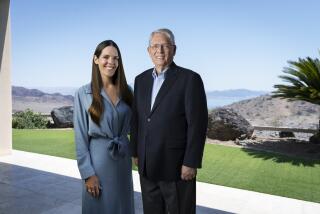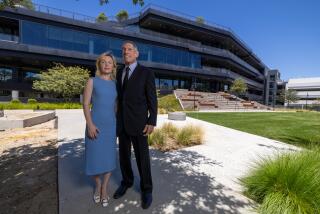Cancer Centerâs âFatherâ Leaving
Cancer is an elusive sickness. Time and again, researchers report finding exciting new treatments for the disease; time and again, the âtreatmentsâ end in disappointment. And the patients keep dying.
Still, Dr. John Mendelsohn isnât discouraged.
Mendelsohn, 48, thinks a âsubstantial decreaseâ in cancer deaths will occur by the year 2000, based on research at institutions including the UC San Diego Cancer Center, which he has directed for eight years.
His UCSD record recently helped win him one of the most coveted posts in American medicine. Beginning July 1, he will become chairman of the department of medicine of the renowned Sloan-Kettering Memorial Hospital in New York City, the largest cancer hospital in the world.
âHeâs done a spectacular job here and established a major cancer center. We feel very sad that he is leaving,â UCSD assistant chancellor Patrick Ledden said on behalf of University Chancellor Richard Atkinson.
Since 1977, Mendelsohn has managed to turn UC San Diego Medical Centerâs cancer division from a minuscule operation into a three-story facility devoted to cancer research and treatment. There, scientists attack cancer with weapons ranging from âmagic bulletsâ to deadly drugs that, carelessly used, would kill rather than cure.
For his achievements, Mendelsohn was named last month as âHeadliner of the Year for 1984 for Medicine/Scienceâ by the San Diego Press Club.
Particularly promising is UCSD scientistsâ work in areas undreamed of a decade ago: new kinds of antibodies that attack cancer cells, injections of drugs into body cavities and medications that âblockâ cancer-promoting biochemicals, called growth factors, Mendelsohn said in a recent interview.
Three hundred to 400 patients a year--about one-fourth of the annual total--undergo experimental therapies âwhich, eight years ago, they would have had to go out of town to get,â Mendelsohn said. Under his leadership, the research budget has grown from about $250,000 a year to about $5 million a year. Most of the money comes from the federal National Cancer Institute.
Still, thereâs never quite enough research money, he acknowledged. âIf there were one less missile built, we probably could increase our medical research budget by a substantial amount.â
âIâve loved it here, spent 15 years of my life here. I never planned on leaving San Diego,â said Mendelsohn, who was born in 1936 in Cincinnati and graduated in 1963 from Harvard Medical School. âBut what Iâve learned is you donât know exactly whatâs going to happen.â
He and his wife, Anne, and their three children live in La Jolla.
Mendelsohn hopes that at Sloan-Kettering he can promote studies of the possibility that growth factors may fuel some cancerous growths. As Sloan-Kettering chief of medicine, he will be in charge of overseeing other doctorsâ treatment of patients. He will also head the developmental program, which raises money for research.
Looking back on his leadership of the cancer center, he happily recalls the âbanner yearâ of 1977 when he recruited to UCSD a number of talented researchers, among them Dr. Steven Howell and Dr. Ivor Royston.
Royston and his colleagues are developing monoclonal antibodies, the so-called âmagic bulletsâ that might eventually allow doctors to assault cancers with deadly drugs without harming useful cells.
When monoclonals were first discovered in England in 1975, researchers hoped they would be used to deliver quick, knockout punches to cancers. However, things havenât quite worked out that way.
In theory, ordinary antibodies will seek out and destroy a wide range of invading microorganisms, or antigens. But monoclonal antibodies--âmonoclonalsâ for short--are combined with poisons and designed to kill only selected antigens such as cancer cells.
So far, UCSD researchers have used monoclonals to locate and attack cancers with greater precision. Dr. Ronald Dillman, Royston and others have given monoclonals to more than 100 patients suffering from lymphoid tumors, bowel cancer or melanoma, a cancer of the cells responsible for skin pigmentation.
Some tumors have shrunk, but the injections havenât yet âproduced long-term benefits. Theyâre still considered an experiment,â Mendelsohn said. So he and his colleagues advise patients who request monoclonal injections that standard chemotherapy remains a better bet.
One problem with monoclonals is that despite their celebrated âprecision,â they sometimes travel to unsuspected places in the body, especially the liver. âWe have to do a lot of fine tuning now,â Mendelsohn said.
Another major area of cancer research at UCSD involves ovarian cancer. Howell and his colleagues inject heavy doses of the drug cisplatin directly into the body cavity that contains the ovaries. Normally, such potent drugs would threaten the patientâs overall health, but Howell and Green protect the rest of the body by injecting the bloodstream with an antidote that neutralizes the cisplatin as it leaks into the rest of the body.
The injections âhave clearly shown a new approach to the treatment of ovarian cancer and cancer in body cavities,â Mendelsohn said. âWe know there are a number of patients who had extensive disease where it could be very clearly documented (that) the cancer disappeared . . . In some of these cases, lives were prolonged.â
Also, UCSD researchers are exploring so-called growth factors, which affect how a cell multiplies. They think that in unusual instances, a growth factor can trigger a cancer.
An example of such research is that undertaken by UCSD scientist Dr. Gordon Gill. Last week Gill was awarded $77,500 by the American Cancer Society for his study of epidermal growth factor, which makes the skin cells multiply. Gillâs efforts stem from the notion that an increase in the number of epidermal growth factor receptors also accelerates cancerous growth, and he hopes to develop drugs that would starve the cancer by keeping the growth factor away.
Preliminary tests on mice suggests that tumor growth can be stalled by injecting the creatures with monoclonal antibodies that counteract the effects of growth factors, Mendelsohn said.
Of course, increased knowledge doesnât automatically lead to improved patient care. As Mendelsohn observes: âWeâve understood what causes sickle cell anemia since 1946 and we can do very little to help someone who has sickle cell anemia, even though I could write on a blackboard a detailed explanation of whatâs going on in that patient.â
Still, the terrifying diseases of the past have become the almost forgotten diseases of today. Likewise, research might gradually erode the menace of cancer, he said.
For example, âin the 1300s and 1600s the plague was one of the major causes of death; what solved it was sanitation. In 1900, the major causes of death were probably tuberculosis and lung diseases; there were tuberculosis sanitaria all over this country . . . When I was in training, we had iron lungs--and along came the (Salk-Sabin) vaccine. The most common sight every summer at all the major hospitals in the 1950s was patients lined up in iron lungs--and now, none of us would know how to use one.â






